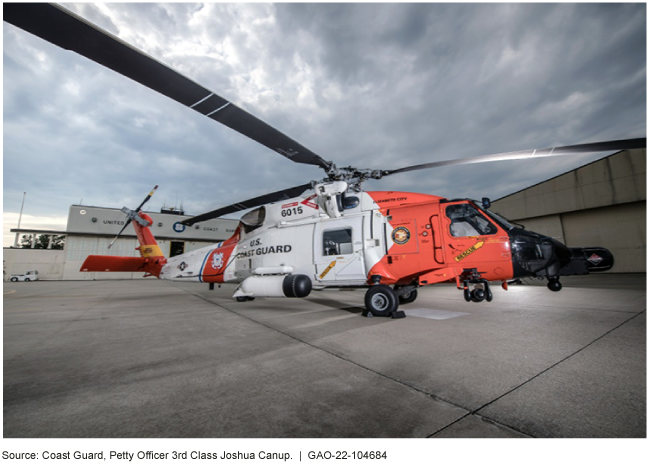DHS Annual Assessment: Most Acquisition Programs Are Meeting Goals Even with Some Management Issues and COVID-19 Delays
Fast Facts
This is our 7th annual assessment of cost and schedule goals for the Department of Homeland Security's major acquisition programs.
We reviewed 23 programs with approved baselines—which establish how the system being acquired will perform, when it will be delivered, and what it will cost. We found that 20 were meeting their cost and schedule goals by the end of fiscal year 2021. The other 3 programs faced challenges such as supply chain issues or underestimating the complexity of their programs.
DHS's acquisition management continues to be a High Risk issue.
Medium Range Recovery Helicopter – Coast Guard

Highlights
What GAO Found
The Department of Homeland Security (DHS) invests billions of dollars annually to acquire systems that help secure the border, increase marine safety, screen travelers, enhance cybersecurity, improve disaster response, and execute a wide variety of other operations.
As of September 2021, 23 of the 29 programs GAO selected for this review had developed a DHS-approved acquisition program baseline—establishing how the system being acquired will perform, when it will be delivered, and what it will cost—and 20 of those 23 programs were meeting their goals. However, five programs exceeded their cost or schedule goals, or both, at some point during fiscal year 2021. Reasons for the breaches included external factors, such as COVID-19, and an underestimation of program complexity. While two of these five programs restructured their baseline goals to get back on track, the remaining three were still in breach status as of September 2021 (see table).
DHS Major Acquisition Programs in Breach of Approved Cost or Schedule Goals (or both) as of September 2021
|
Program (baseline life-cycle cost) |
Breach type |
|---|---|
|
Homeland Advanced Recognition Technology ($3.9 billion) |
Cost and schedule |
|
Medium Range Surveillance Aircraft ($15.2 billion) |
Schedule |
|
National Bio and Agro-Defense Facility ($1.3 billion) |
Schedule |
Source: GAO analysis of Department of Homeland Security data | GAO-22-104684
Additionally, GAO found that nine programs that were meeting their currently established goals rebaselined or were in the process of doing so in fiscal year 2021 due to scope changes, such as a change in quantities, an extended life cycle, or additional funding from Congress.
As of September 2021, GAO found that four programs used a DHS policy allowing programs to adjust schedule milestones up to 6 months due to the effects of COVID-19. These effects included workforce absences due to stay-at-home orders and supply chain delays for needed parts. In most cases, programs were able to mitigate the effects of COVID-19 without baseline adjustments.
Why GAO Did This Study
In 2015, a Senate report included a provision for GAO to review DHS's major acquisitions. This is GAO's seventh review of the cost and schedule performance of selected major DHS acquisition programs. This report examines the extent to which these programs are meeting baseline goals and describes efforts to mitigate COVID-19–related effects on delivery of capabilities to end users.
GAO assessed 29 acquisition programs, including DHS's largest programs and those that GAO identified as at risk of poor outcomes, to determine program status as of September 30, 2021. GAO assessed progress in meeting cost and schedule goals; reviewed policy, memorandums, and information about the cost and schedule effects of COVID-19; and interviewed DHS officials.
For more information, contact Marie A. Mak at (202) 512-4841 or makm@gao.gov.

